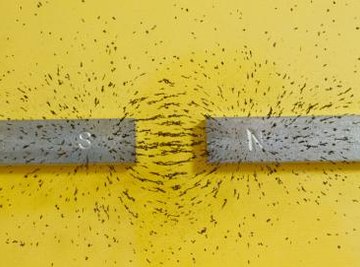
Rare earth magnets are made from the rare earth elements, which have atomic numbers ranging from 57 to 71. These elements are so named because they were thought to be rare when they were first discovered, although they are now known to be relatively common. The strongest and most common type of rare earth magnet is made from an alloy of neodymium, iron and boron. These magnets were very expensive when they were first developed in the late 1970s and early 1980s, but they are now common enough to be used in children’s toys.
- Iron boron
- Neodymium
- Steel or rubber molds
Grind solid ingots of neodymium and iron boron into a powder. This operation consists of three separate phases. The ingots are mechanically crushed into coarse particles and then mechanically ground into finer pieces. In the final phase, these particles are jet milled into highly spherical particles that are only a few microns in diameter. Jet milling uses highly pressurized gas in an inert atmosphere to make very small particles and provides a high degree of control over the specific size of the particles.
Compact the powder into a mold. Steel molds will provide the final shape of the magnet, and rubber molds produce rough bricks of the neodymium alloy to be shaped later. Press the rubber mold on all sides at once, a process known as isostatic pressing.
Apply a magnetic field to the rare earth magnets during the pressing operation. Use a magnetic field in the 4 tesla range from a very powerful electromagnet along the magnet's axis of magnetisation. This will greatly increase the alignment of the magnetic particles in the alloy and vastly improve the magnetic properties of the finished magnet.
Sinter the rare earth magnets. Heat the magnet in a vacuum in a sintering furnace to about 1,000 dregrees Celsius, which allows the neodymium to melt but not the iron or boron. The temperature must be very carefully controlled so that it doesn't increase the size of the individual particles in the magnet. This specific type of sintering is known as liquid phase sintering and will provide the magnets with their final magnetic strength.
Shape the bricks made with rubber molds. Grind the bricks to the general shape desired and slice them into their final form. Coat the magnets to protect them from chipping as they are extremely brittle. There are a wide variety of surface treatment options for rare earth magnets, depending on the specific application. The most common choices of metals include gold, nickel, tin and zinc. Rare earth magnets are also frequently coated with an epoxy resin.
Things You'll Need
References
About the Author
Allan Robinson has written numerous articles for various health and fitness sites. Robinson also has 15 years of experience as a software engineer and has extensive accreditation in software engineering. He holds a bachelor's degree with majors in biology and mathematics.
Photo Credits
Jupiterimages/Photos.com/Getty Images
